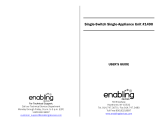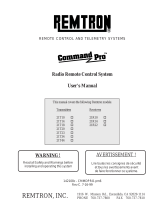
TABLE OF CONTENTS
1.0: CRITICAL INSTALLATION CONSIDERATIONS ..................................................................... 3
1.1 GENERAL .............................................................................................................................. 3
1.2 PERSONS AUTHORIZED TO OPERATE RADIO CONTROLLED EQUIPMENT ................ 3
1.3 SAFETY INFORMATION & RECOMMENDED TRAINING FOR OPERATORS .................. 4
1.4 PRE-OPERATION TEST ....................................................................................................... 5
2.0 FLEX M RECEIVER INSTALLATION ....................................................................................... 6
2.1 PRE-INSTALLATION ............................................................................................................. 6
2.2 MECHANICAL DRAWINGS ................................................................................................... 7
2.3 INSTALLATION ..................................................................................................................... 8
2.4 REMOVAL.............................................................................................................................. 9
3.0 NORMAL OPERATION ........................................................................................................... 10
3.1 POWER SUPPLY MODULE ................................................................................................ 10
3.2 RF/CPU MODULE ............................................................................................................... 10
3.3 RELAY MODULE(S) ............................................................................................................ 10
4.0 FLEX MODULE TYPES .......................................................................................................... 11
4.1 FLEX RF/CPU MODULE ..................................................................................................... 11
4.1.1 Bank 1 Dip Switch Setting Definitions ....................................................................... 11
4.1.1.1 Bank 1 Switches 1 through 5 – Relay configuration program select ................. 11
4.1.1.2 Bank 1 Switch 6 – Invert A/B Select Outputs (Normally OFF) .......................... 11
4.1.1.3 Bank 1 Switch 7 – Auxiliary Relay Output Select (Normally OFF) .................... 12
4.1.1.4 Bank 1 Switch 8 – Disable Tandem (A/B both) Select (Normally OFF) ............ 12
4.1.2 Bank 2 Dip Switch Setting Definitions ....................................................................... 12
4.1.2.1 Bank 2 Switch 1 – AUX 1/2 Output Configuration (Normally ON) ..................... 12
4.1.2.2 Bank 2 Switch 2 – AUX 3/4 Output Configuration (Normally ON) ..................... 12
4.1.2.3 Bank 2 Switch 3 – AUX 5/6 Output Configuration (Normally ON) ..................... 13
4.1.2.4 Bank 2 Switches 4 thru 8 – Radio Frequency channel select ........................... 13
4.2 FLEX M RELAY MODULE ................................................................................................... 13
4.3 FLEX M 120VAC POWER MODULE .................................................................................. 14
5.0 FLEX SYSTEMS – OVERVIEW, SETTINGS AND WIRING DIAGRAMS .............................. 16
5.1 FLEX M-16 SYSTEM OVERVIEW ...................................................................................... 16
5.1.1 Flex M 16 Relay Configuration Settings (Bank 1 on RF/CPU Module) ......................... 16
5.1.2 Flex M 16 Relay Configuration Descriptions ................................................................. 17
5.2 FLEX M-24 SYSTEM OVERVIEW ...................................................................................... 21
5.2.1 Flex M 24 Relay Configuration Settings (Bank 1 on RF/CPU Module) ......................... 21
5.2.2 Flex M 24 Relay Configuration Descriptions ................................................................. 22
5.3 FLEX M-32 SYSTEM OVERVIEW ...................................................................................... 23
5.3.1 Flex M 32 Relay Configuration Settings (Bank 1 on RF/CPU Module) ......................... 23
5.3.2 Flex M 32 Relay Configuration Descriptions ................................................................. 24
6.0 CHANNEL CONFIGURATION SETTINGS (BANK 2 ON RF/CPU MODULE) ....................... 27
6.1 FCC STATEMENTS ............................................................................................................ 27
7.0 TROUBLESHOOTING ............................................................................................................ 28
7.1 TROUBLESHOOTING TABLE ............................................................................................ 29
7.2 ASSEMBLY AND REPLACEMENT PARTS ........................................................................ 31


































